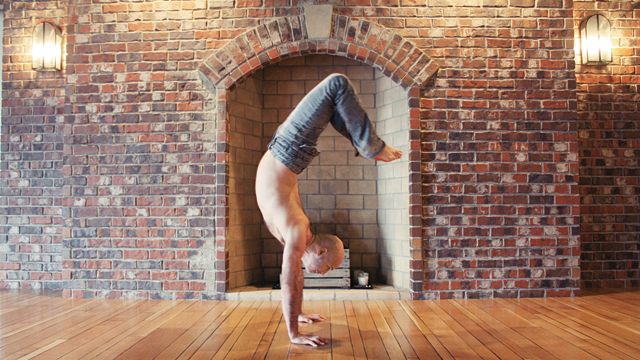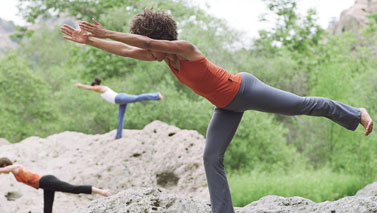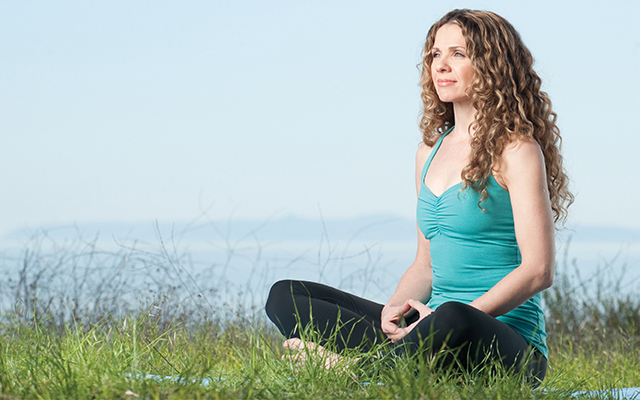Renowned yoga teacher Jonny Kest is a longtime Vinyasa practitioner and founder of the Center for Yoga in Michigan; recently he also became the national director of yoga for Life Time Fitness. With more than two decades of practice and training in the United States and India under his belt, Kest has a wealth of insights about the benefits of yoga for mind and body alike. Recently, he shared some of them with Experience Life senior editor Courtney Helgoe.
EL | How did you get involved with yoga?
JK | My father suffered from serious back problems. When I was young he had several surgeries because his pain was so excruciating. Unfortunately, more than 15 percent of all back surgeries fail, and that’s what happened to my father in all three of his cases. He was a surgeon, so the first thing he did was seek conventional medical treatment, and when that didn’t work, he was in bad shape. Someone said, “Why don’t you try yoga?” This was 30 years ago, and yoga wasn’t in any way as popular as it is today. But it just so happened that Sri Pattabhi Jois [the founder of Ashtanga yoga] was coming to America, and my father took his workshop. He couldn’t believe it — the benefits were immediate.
He was so impressed with Jois that he took me to India to visit him when I was 15. When I came back home, my gym teacher asked me to share my experience with the class once a week, teaching yoga. So that’s how I got started.
EL | That’s an interesting point of entry — especially since a lot of people with back pain think they shouldn’t do yoga, or they’re afraid to.
JK | I think the reason that surgery didn’t work for my father, and yoga did, was because yoga got to the root of his problem. Dr. John Sarno of New York University School of Medicine says that 95 percent of back pain is tension-related; only 5 percent is structural. You can have all the back surgeries you want, but if you keep building tension, it won’t help. Many of us are tense and walking around oxygen deprived, not breathing, not getting enough oxygen into those deepest tissues. That creates inflammation and pain. Yoga teaches you how to breathe and relax, which helps oxygenate tissues. I think that’s why it’s one of the most effective ways of helping people deal with all sorts of tension-related diseases.
Whenever we’re in an uncomfortable position at work or at home, we tend to hold our breath and tighten. So in yoga, you put yourself into an uncomfortable posture intentionally, and breathe and relax. Rather than using your body to get into the postures, you use the postures to get into your body. Your body will figure out what needs to be healed.
EL | Which yoga traditions are most influential in your practice?
JK | The Ashtanga yoga practice I learned in India is my foundation, though I teach Vinyasa. Ashtanga is the classical ballet — while Vinyasa is the free-flowing outgrowth of that practice, the modern dance. It’s more accessible.
EL | How has meditation influenced your yoga practice?
JK | With Ashtanga, it’s very easy [to focus on posture] because you have “first series,” “intermediate series,” and “second series” of postures. You have advanced A and advanced B. When you go to India, I think everybody wants to learn all the poses and be able to master them. It’s almost like a posture race.
When I was 23, my father told me about Vipassana meditation, and I went on a 10-day silent meditation retreat. It was free — at the end of the course one can make a donation for a future student, but someone already donated for me. You’re basically there as a monk or a nun, and it was pretty amazing to be involved in something so totally noncommercial.
It became really clear to me after this 10-day meditation that yoga isn’t about mastering poses. It’s about mastering your mind. The real work is on this wild mind of ours. That changed my whole yoga practice. Instead of trying to use my body to master the poses, I started using the poses to master my mind. And that changed my life.
I went to that 10-day retreat with a girlfriend. I was really young, and up to that point I had been so wild I could never make a commitment. But after that retreat, I ended up marrying that woman. We have four kids and we’ve been together for over 25 years. It was one of those beautiful epiphanies that come with really hard work.
EL | Your teacher-training program promises to help teachers “take their practice to a deeper level.” Could you say more about the difference between a superficial practice and a deep one?
JK | The teacher training is not just about the art of teaching but the art of living yoga. All the students are taught how to eat a yoga meal, which is not what you eat but how you eat. It’s basically mindfulness eating. When you come to your breath and eat with awareness, you realize that how you eat your food is as or more important to your weight and your health as what you’re eating.
A lot of people come to teacher training and they think they’re just going to learn how to do the poses right. But rather than make the training about correcting students, I teach that it’s more about connecting. Connecting with what they’re doing; connecting with their food; connecting with their breath and their relationships.
I have students close their eyes and they feel their own lines of energy. They feel those energetic connections, rather than being corrected from the outside. Students are so intuitive and energetically intelligent. Ultimately, to me the best teacher is the one who can get out of the way and let the students really be. The smartest intuitive teachers I’ve found in the room are the students’ bodies.
EL | Do you do any form adjustments for your students in class?
JK | Yes. But again, it’s more about creating awareness and connecting with students than putting them in the right pose. There is an archetype of every posture. I’ll get them into the basic shape, the basic archetype. Then I’ll offer awareness cues, like “notice the direction of your feet.” Or I’ll have them become aware of what they are holding on to. Then they can make those adjustments. It’s not like I let them just do whatever they want. We teach the ability to choose your own response. Students are always reacting. And when you react to something, you have no choice. But if you can come to your breath and not react, you have so many choices.
EL | How do you practice yoga off the mat?
JK | The word “yoga” — are you aware of the traditional translation?
EL | To yoke together?
JK | Right: You and your inner self bind, come together. But I like to put things in more practical terms, what they mean in everyday life. The word “yoga” means relationship. It teaches you how to be in a relationship, with anything — no matter how comfortable or uncomfortable — and come out successfully. On and off the mat, that’s what yoga is all about.




This Post Has 0 Comments